Top Rankings
Linn-Mar Comm School District ranks among the top 20% of public school district in Iowa for:
Category
Attribute
Graduation Rate
Highest graduation rate (Top 5%)
Diversity
Most diverse schools (Top 1%)
Community Size
Largest student body (number of students) (Top 1%)
For the 2025 school year, there is 1 public high school serving 2,222 students in Linn-Mar Comm School District. This district's average high testing ranking is 5/10, which is in the bottom 50% of public high schools in Iowa.
Public High School in Linn-Mar Comm School District have an average math proficiency score of 68% (versus the Iowa public high school average of 60%), and reading proficiency score of 68% (versus the 71% statewide average).
Public High School in Linn-Mar Comm School District have a Graduation Rate of 96%, which is more than the Iowa average of 88%.
The school with highest graduation rate is Linn-mar High School, with 96% graduation rate. Read more about public school graduation rate statistics in Iowa or national school graduation rate statistics.
Minority enrollment is 25% of the student body (majority Black and Asian), which is less than the Iowa public high school average of 27% (majority Hispanic).
Overview
This School District
This State (IA)
# Schools
12 Schools
365 Schools
# Students
7,462 Students
171,507 Students
# Teachers
513 Teachers
11,091 Teachers
Student : Teacher Ratio
15:1
15:1
District Rank
Linn-Mar Comm School District, which is ranked within the top 30% of all 325 school districts in Iowa (based off of combined math and reading proficiency testing data) for the 2021-2022 school year.
The school district's graduation rate of 96% has increased from 92% over five school years.
Overall District Rank
#93 out of 327 school districts
(Top 30%)
(Top 30%)
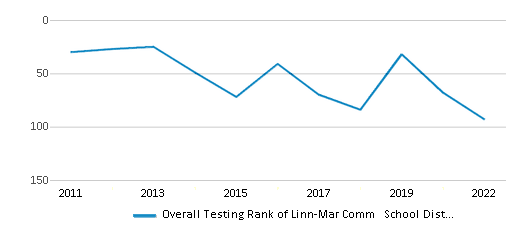
Math Test Scores (% Proficient)
74%
64%
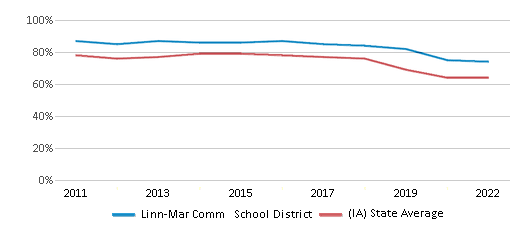
Reading/Language Arts Test Scores (% Proficient)
75%
70%
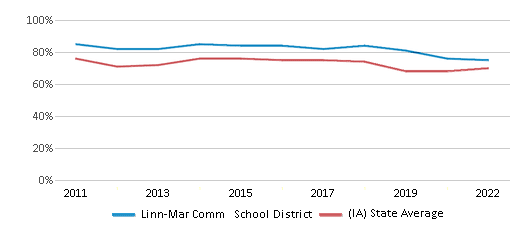
Science Test Scores (% Proficient)
69%
63%
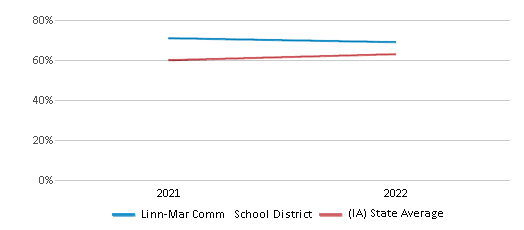
Graduation Rate
96%
90%
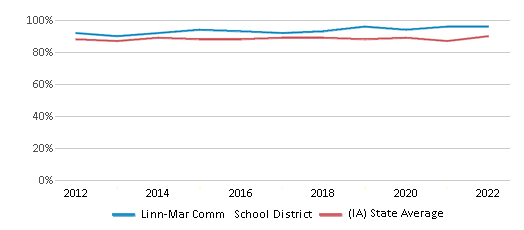
Students by Ethnicity:
Diversity Score
0.43
0.45
# American Indian Students
11 Students
796 Students
% American Indian Students
n/a
1%
# Asian Students
557 Students
3,901 Students
% Asian Students
8%
2%
# Hispanic Students
407 Students
21,518 Students
% Hispanic Students
5%
13%
# Black Students
439 Students
10,972 Students
% Black Students
6%
6%
# White Students
5,557 Students
125,591 Students
% White Students
75%
73%
# Hawaiian Students
5 Students
863 Students
% Hawaiian Students
n/a
1%
# Two or more races Students
464 Students
7,560 Students
% of Two or more races Students
6%
4%
Students by Grade:
# Students in PK Grade:
209
56
# Students in K Grade:
532
70
# Students in 1st Grade:
540
87
# Students in 2nd Grade:
519
83
# Students in 3rd Grade:
554
82
# Students in 4th Grade:
540
105
# Students in 5th Grade:
641
218
# Students in 6th Grade:
563
1,345
# Students in 7th Grade:
569
5,175
# Students in 8th Grade:
573
7,975
# Students in 9th Grade:
552
39,092
# Students in 10th Grade:
573
39,818
# Students in 11th Grade:
551
38,859
# Students in 12th Grade:
546
38,542
# Ungraded Students:
-
-
District Revenue and Spending
The revenue/student of $16,871 is higher than the state median of $16,468. The school district revenue/student has stayed relatively flat over four school years.
The school district's spending/student of $16,098 is higher than the state median of $16,042. The school district spending/student has stayed relatively flat over four school years.
Total Revenue
$126 MM
$8,262 MM
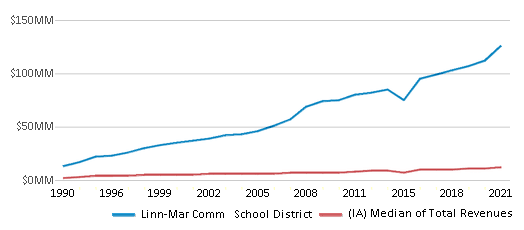
Spending
$120 MM
$8,048 MM

Revenue / Student
$16,871
$16,468
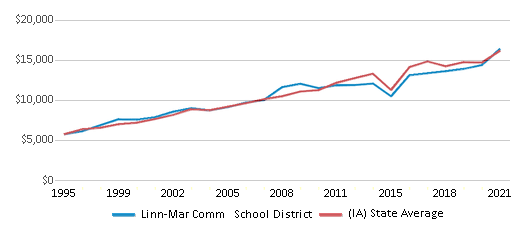
Spending / Student
$16,098
$16,042
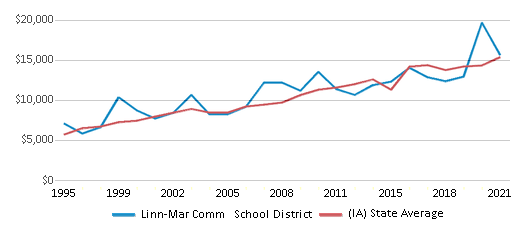
Best Linn-Mar Comm School District Public High Schools (2025)
School
(Math and Reading Proficiency)
(Math and Reading Proficiency)
Location
Grades
Students
Rank: #11.
Linn-mar High School
(Math: 68% | Reading: 68%)
Rank:
Rank:
5/
Bottom 50%10
3111 N 10th St
Marion, IA 52302
(319) 447-3040
Marion, IA 52302
(319) 447-3040
Grades: 9-12
| 2,222 students
Recent Articles

What Is A Charter School?
Explore the world of charter schools in this comprehensive guide. Learn about their history, how they operate, and the pros and cons of this educational innovation. Discover key facts about charter schools, including admission policies, demographics, and funding, as well as what to look for when considering a charter school for your child.

10 Reasons Why High School Sports Benefit Students
Discover the 10 compelling reasons why high school sports are beneficial for students. This comprehensive article explores how athletics enhance academic performance, foster personal growth, and develop crucial life skills. From improved fitness and time management to leadership development and community representation, learn why participating in high school sports can be a game-changer for students' overall success and well-being.

February 05, 2025
Understanding the U.S. Department of Education: Structure, Impact, and EvolutionWe explore how the Department of Education shapes American education, from its cabinet-level leadership to its impact on millions of students, written for general audiences seeking clarity on this vital institution.





